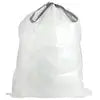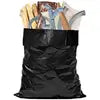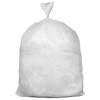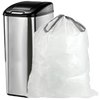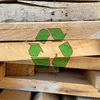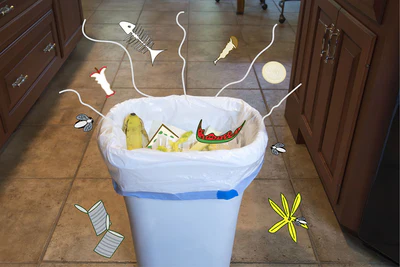Garbage bags are a sort of twentieth-century miracle. Since 1950, when first invented by Canadian inventor Harry Wasylyk, garbage bags have revolutionized our sanitation and cleanliness process – versus the old method of letting garbage pile up in germ-ridden metal cans.
Wasylyk created the first trash bag in a chemistry lab. But how are garbage bags manufactured today? Today, garbage bags are created in large plants using heavy machinery. They are created in long tubes, then cut and separated to produce individual bags. Working with molten plastic can be surprisingly delicate and beautiful! Here’s a simple explanation of the process.
Trash bags are made from polyethylene – a tough, light, flexible plastic used chiefly in containers, insulation, and packaging. Polyethylene got its name because it is a polymer (a type of chemical compound) of ethylene, a colorless gas used in the production of many chemicals. Polyethylene is resistant to chemicals and moisture, and has good insulating properties.
Resin pellets are small, hard cylindrical shaped plastic particles. To make garbage bags, polyethylene resin pellets are poured into large hoppers, or containers used for pouring materials into a machine or opening.The resin pellets then enter an extruder – a machine that melts the pellets by heating them to a temperature between 365 and 465 degrees Fahrenheit. Once the pellets are heated and thoroughly mixed by the extruder the remaining raw plastic mixture is then pushed through a die. A die, or a special tool to cut or shape material, forms the plastic into a ring. The ring is then blown into a bubble – surprisingly elegant and shimmery, similar in appearance to a large, glistening soap bubble.
Heated Polyethylene Bubbles
Source: Aluf Plastics
The plastic tube gradually cools down. It is several hundred feet long, and it has a minimum thickness of two ten-thousands of an inch. Next, rollers collapse the bubble into a flat tube, called a film, which is easy to work with.
Source: Aluf Plastics
A knife cuts the film to the desired width. Extra film is salvaged in a tube. The tube of flattened film is heat-sealed on one side. The film is perforated, then cut into bags.
Next, the trash bags are then folded, stacked, and inserted into their packaging. The pristine, new garbage bags are all set to arrive at your home!
Sources:
• Penn State University
• Aluf Plastics
 4.9 out of 5
4.9 out of 5  Save 20% Off Sitewide - Discount in cart.
Save 20% Off Sitewide - Discount in cart.













